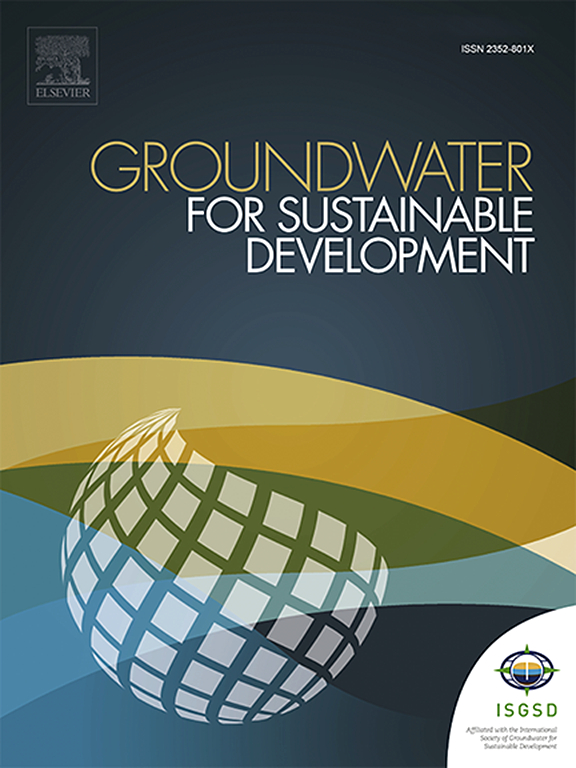Pyrethroids in groundwater near the Citarum River: Insights into ecological and health risks
IF 4.9
Q2 ENGINEERING, ENVIRONMENTAL
引用次数: 0
Abstract
While pyrethroid presence in rivers in Indonesia, particularly the Citarum River, has been reported, no studies have documented its occurrence in groundwater. This study is the first to report pyrethroid contamination in groundwater in Indonesia. We examine the distribution of pyrethroid concentrations in groundwater near the Citarum River in relation to distance from the river and evaluate the associated ecological and health risks. Of the nine pyrethroids tested, five were detected in Citarum River samples, and all were found in groundwater well samples, exceeding the maximum permissible concentration. Allethrin and β-cyfluthrin were detected in all water samples at concentrations of 101–264 ng/L and 12–58 ng/L, respectively. Although allethrin concentrations decreased with increasing distance from the river and increased with decreasing elevation, no significant correlation was found between distance, elevation, and allethrin concentrations. No distinct pattern was observed for β-cyfluthrin in river and groundwater samples. Additionally, neither allethrin nor β-cyfluthrin showed a significant correlation with proximity to agricultural areas, indicating that contamination sources may not be solely related to agricultural activities. Ecological risk assessment revealed that pyrethroid contamination poses a significant ecological threat to the Citarum River (Total Risk Quotient (TRQ) ≥ 1). However, total non-carcinogenic risk levels for pyrethroids in all groundwater samples were below 1, indicating no non-cancer health risks. These findings highlight the need for further research on pyrethroid dynamics and land-use interactions.

Citarum河附近地下水中的拟除虫菊酯:对生态和健康风险的见解
虽然据报道在印度尼西亚的河流,特别是Citarum河中发现了拟除虫菊酯类杀虫剂,但没有研究证明它在地下水中存在。这项研究首次报道了印度尼西亚地下水中的拟除虫菊酯污染。我们研究了Citarum河附近地下水中拟除虫菊酯浓度的分布与河流距离的关系,并评估了相关的生态和健康风险。在9个检出拟除虫菊酯的样本中,有5个在Citarum河样本中检出,而所有样本均在地下水井样本中检出,均超过最高容许浓度。所有水样中均检测到丙烯菊酯和β-氟氯菊酯,浓度分别为101 ~ 264 ng/L和12 ~ 58 ng/L。尽管丙烯菊酯浓度随距离河流的增加而降低,随海拔的降低而升高,但距离、海拔与丙烯菊酯浓度之间没有显著的相关性。β-氟氯菊酯在河流和地下水样品中没有明显的分布规律。此外,乙酰氰菊酯和β-氟氯菊酯均未显示出与靠近农业区有显著相关性,这表明污染源可能不仅仅与农业活动有关。生态风险评估结果显示,拟除虫菊酯类杀虫剂污染对西塔鲁姆河造成显著生态威胁(总风险商(Total risk Quotient, TRQ)≥1),但所有地下水样品中拟除虫菊酯类杀虫剂的总非致癌性风险水平均低于1,不存在非致癌健康风险。这些发现突出了进一步研究拟除虫菊酯类杀虫剂动态和土地利用相互作用的必要性。
本文章由计算机程序翻译,如有差异,请以英文原文为准。
求助全文
约1分钟内获得全文
求助全文
来源期刊

Groundwater for Sustainable Development
Social Sciences-Geography, Planning and Development
CiteScore
11.50
自引率
10.20%
发文量
152
期刊介绍:
Groundwater for Sustainable Development is directed to different stakeholders and professionals, including government and non-governmental organizations, international funding agencies, universities, public water institutions, public health and other public/private sector professionals, and other relevant institutions. It is aimed at professionals, academics and students in the fields of disciplines such as: groundwater and its connection to surface hydrology and environment, soil sciences, engineering, ecology, microbiology, atmospheric sciences, analytical chemistry, hydro-engineering, water technology, environmental ethics, economics, public health, policy, as well as social sciences, legal disciplines, or any other area connected with water issues. The objectives of this journal are to facilitate: • The improvement of effective and sustainable management of water resources across the globe. • The improvement of human access to groundwater resources in adequate quantity and good quality. • The meeting of the increasing demand for drinking and irrigation water needed for food security to contribute to a social and economically sound human development. • The creation of a global inter- and multidisciplinary platform and forum to improve our understanding of groundwater resources and to advocate their effective and sustainable management and protection against contamination. • Interdisciplinary information exchange and to stimulate scientific research in the fields of groundwater related sciences and social and health sciences required to achieve the United Nations Millennium Development Goals for sustainable development.
 求助内容:
求助内容: 应助结果提醒方式:
应助结果提醒方式:


